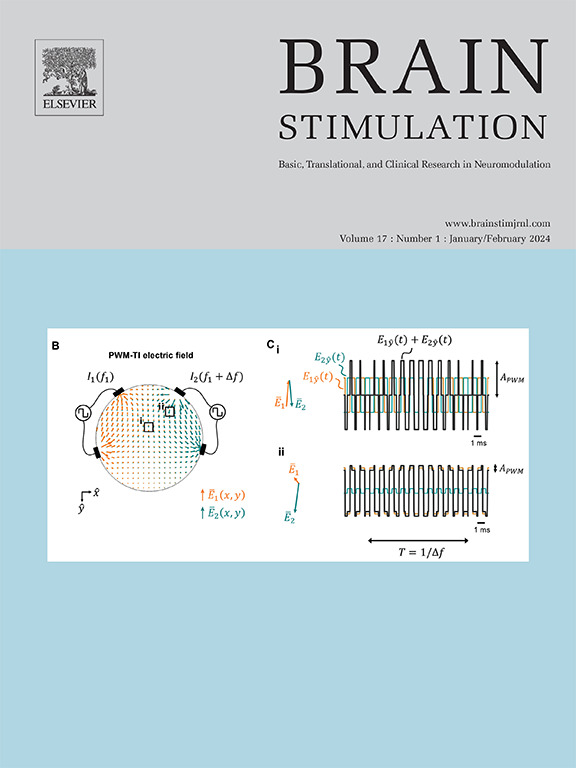患者主观评分作为帕金森病DBS规划的新反馈信号。
IF 7.6
1区 医学
Q1 CLINICAL NEUROLOGY
引用次数: 0
摘要
背景:丘脑底核深部脑刺激(STN-DBS)可有效缓解帕金森病(PD)的运动波动。最佳电极放置和有效的编程显著影响结果。从患者的角度来看,DBS应该缓解运动症状,同时避免副作用。然而,缺乏考虑患者主观反馈进行参数调整的编程程序。目的:本研究评估患者主观评分作为DBS计划反馈的有用性。方法:我们分析了11例STN-DBS患者的260个DBS设置,将每个组织激活量(VTA)与视觉模拟量表(VAS)测量的主观评分配对。我们进行了最佳点映射和连通性分析,利用体素和非参数排列统计来识别与最高VAS评分相关的神经解剖区域和连通性概况。为了验证我们的发现,我们在6名患者(189个设置)的独立测试数据集中交叉验证了结果,以确定最佳点和连接概况是否可以预测患者的主观感知。结果:VAS评分最高的VTAs位于STN背外侧,与已发表的临床数据得出的最佳点一致。与辅助运动区(SMA)和初级运动皮层(M1)的连通性与更积极的主观感知相关。来自一个数据集的连通性配置文件成功地预测了独立数据集的结果,并通过留一个队列的交叉验证进行了验证。结论:使用VAS绘制患者的主观感知,得出与客观临床和影像学测量一致的结论性解剖学结果。vas引导的编程可以为急性和慢性DBS参数调整提供额外的反馈机制。本文章由计算机程序翻译,如有差异,请以英文原文为准。

Subjective patient rating as a novel feedback signal for DBS programming in Parkinson's disease
Background
Deep brain stimulation of the subthalamic nucleus (STN-DBS) effectively alleviates motor fluctuations in Parkinson's disease (PD). Optimal electrode placement and effective programming significantly influence outcomes. From a patient's perspective, DBS should relieve motor symptoms while avoiding side effects. However, there is a lack of programming routines that consider patients' subjective feedback for parameter adjustment.
Objective
This study assessed the usefulness of patients' subjective ratings as feedback for DBS programming.
Methods
We analyzed 260 DBS settings from 11 STN-DBS patients, pairing each volume of tissue activated (VTA) with a subjective rating measured by a visual analogue scale (VAS). We performed sweet spot mapping and connectivity analyses, utilizing voxel-wise and nonparametric permutation statistics to identify neuroanatomical regions and connectivity profiles associated with the highest VAS ratings. To validate our findings, we cross-validated the results in an independent test dataset of 6 patients (189 settings) to determine if the sweet spot and connectivity profile could predict the subjective patient perception.
Results
VTAs with the highest VAS scores were localized to the dorsolateral STN, consistent with published sweet spots derived from clinical data. Connectivity with the supplementary motor area (SMA) and primary motor cortex (M1) was associated with a more positive subjective perception. Connectivity profiles derived from one dataset successfully predicted outcomes in an independent dataset, as validated through leave-one-cohort-out cross-validation.
Conclusions
Mapping patients' subjective perceptions using VAS yields conclusive anatomical results that align with objective clinical and imaging measures. VAS-guided programming could provide an additional feedback mechanism for both acute and chronic DBS parameter adjustments.
求助全文
通过发布文献求助,成功后即可免费获取论文全文。
去求助
来源期刊

Brain Stimulation
医学-临床神经学
CiteScore
13.10
自引率
9.10%
发文量
256
审稿时长
72 days
期刊介绍:
Brain Stimulation publishes on the entire field of brain stimulation, including noninvasive and invasive techniques and technologies that alter brain function through the use of electrical, magnetic, radiowave, or focally targeted pharmacologic stimulation.
Brain Stimulation aims to be the premier journal for publication of original research in the field of neuromodulation. The journal includes: a) Original articles; b) Short Communications; c) Invited and original reviews; d) Technology and methodological perspectives (reviews of new devices, description of new methods, etc.); and e) Letters to the Editor. Special issues of the journal will be considered based on scientific merit.
 求助内容:
求助内容: 应助结果提醒方式:
应助结果提醒方式:


